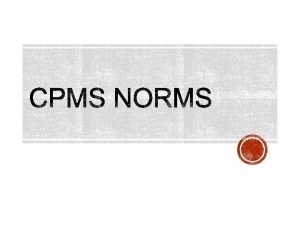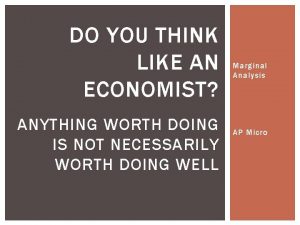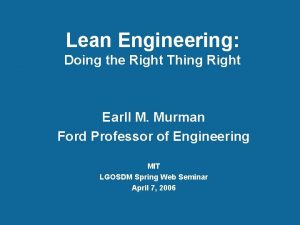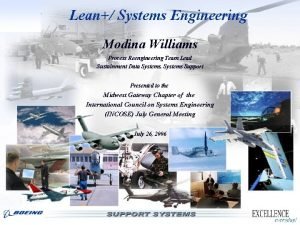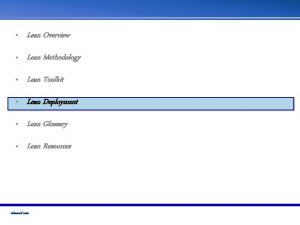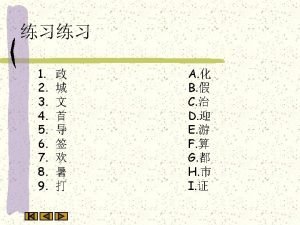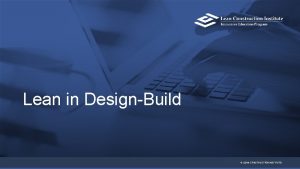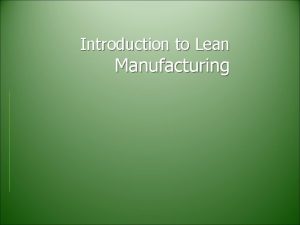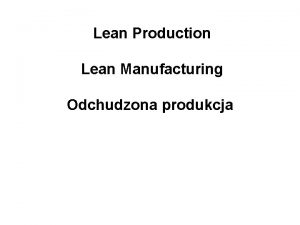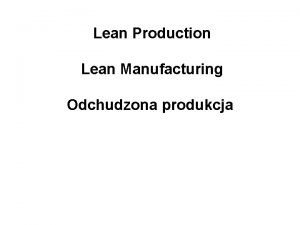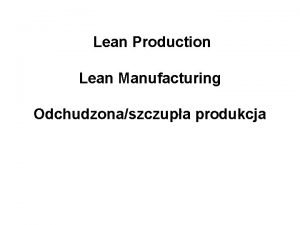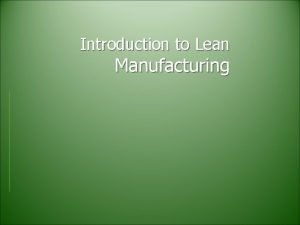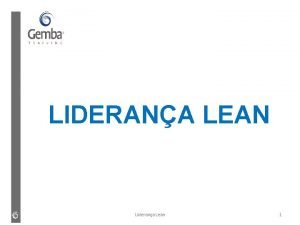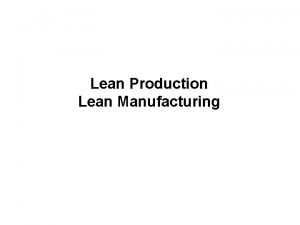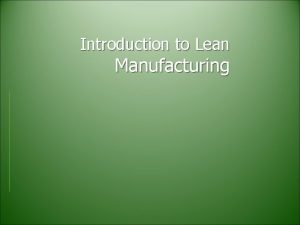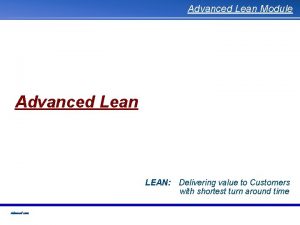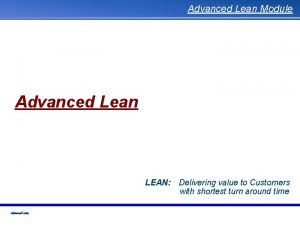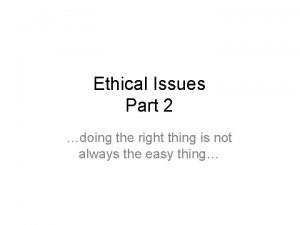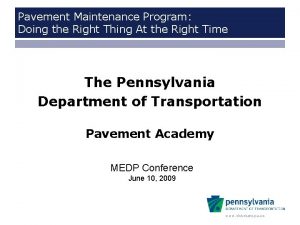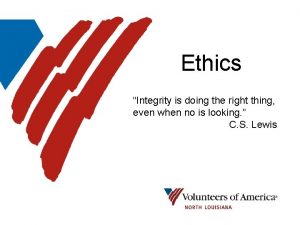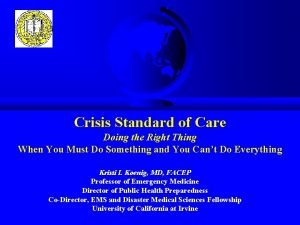Lean Engineering Doing the Right Thing Right Earll





























- Slides: 29

Lean Engineering: Doing the Right Thing Right Earll M. Murman Ford Professor of Engineering MIT LGOSDM Spring Web Seminar April 7, 2006

Lean Thinking Lean emerged from post-WWII Japanese automobile industry as a fundamentally more efficient system than mass production. This talk focuses on applying Lean Thinking to Engineering Source: Lean Enterprise Value: Insights from MIT’s Lean Aerospace Initiative, Palgrave, 2002. © 2006 Massachusetts Institute of Technology Murman LFMSDM 4/7/06 Web Seminar - 2

Lean Engineering: Doing the Right Thing Right • • Creating the right products… • With effective lifecycle & enterprise integration… • • Creating product architectures, families, and designs that increase value for all enterprise stakeholders. Using lean engineering to create value throughout the product lifecycle and the enterprise. Using efficient engineering processes. • Applying lean thinking to eliminate wastes and improve cycle time and quality in engineering. Source: Mc. Manus, H. L. “Product Development Value Stream Mapping Manual”, LAI Release Beta, April 2004 Framework based upon a decade of Lean Aerospace Initiative research and industry/government implementation © 2006 Massachusetts Institute of Technology Murman LFMSDM 4/7/06 Web Seminar - 3

Creating the Right Products: Creating product architectures, families, and designs that increase value for all enterprise stakeholders. “Fuzzy Front End” Challenges Understanding what the customer values Deciding which product to pursue from amongst many opportunities Source: Fabrycky & Blanchard Selecting the right product concept Early decisions are critical - Disciplined lean systems engineering process is essential! © 2006 Massachusetts Institute of Technology Murman LFMSDM 4/7/06 Web Seminar - 4

Customer Defines Product Value Source: Slack, R. A. , “The Lean Value Principle in Military Aerospace Product Development”, LAI RP 99 -01 -16, Jul 1999. web. mit. edu/lean Product Value is a function of the product • Features and attributes to satisfy a customer need • Quality or lack of defects • Availability relative to when it is needed, and • Price and/or cost of ownership to the customer © 2006 Massachusetts Institute of Technology Murman LFMSDM 4/7/06 Web Seminar - 5

• • Tools Are Needed For Conceptual Design A key to creating the right products are design tools for the conceptual design phase which can handle • Evolving user preferences • Imprecise specifications of product parameters • Varying levels of technology maturity • Market and funding uncertainties • Evolving regulatory, political and other matters One approach: MATE-CON User Needs MATE Architecture Evaluation Source: Hugh Mc. Manus, “Introduction to Tradespace Exploration”, MIT Space System Architecture Class, 2002 ICE CONceptual Design Robust Adaptable Concepts © 2006 Massachusetts Institute of Technology Murman LFMSDM 4/7/06 Web Seminar - 6

MATE-CON Example: Space Tug MATE tradespace Utility = f(complexity, V, speed) Source: Hugh Mc. Manus and Dan Hastings, “Integrated Concurrent Engineering and MATE-CON”, MIT Space Systems Architecture Class, 2004 ICE Result © 2006 Massachusetts Institute of Technology Murman LFMSDM 4/7/06 Web Seminar - 7

With Effective Lifecycle & Enterprise Integration: Using lean engineering to create value throughout the Product Development product lifecycle and the enterprise. In The Value Chain Value Specified Customer Value Delivered Product Development Producible Design Meeting Value Expectations Early Involvement Production Value Created Suppliers as Partners Supplier Network Source: “Lean Engineering”, LAI Lean Academy™, V 3, 2005 © 2006 Massachusetts Institute of Technology Murman LFMSDM 4/7/06 Web Seminar - 8

Integrated Product and Process Development - IPPD • • Preferred approach to develop producible design meeting value expectations Utilizes • • Systems Engineering: Translates customer needs and requirements into product architecture and set of specifications Modern Engineering tools: Enable lean processes Integrated Product Teams (IPTs): Incorporates knowledge about all lifecycle phases Training Capable people, processes and tools are required © 2006 Massachusetts Institute of Technology Murman LFMSDM 4/7/06 Web Seminar - 9

IPPD Reduces Post Design Changes - Aircraft Example Change Ratio The average number of changes made to each drawing after it is released by design IPPD drives knowledge “upstream” to design phase to reduce non-valued added “downstream” changes Source: Hernandez, C. , “Challenges and Benefits to the Implementation of IPTs on Large Military Procurements”. MIT Sloan School SM Thesis, June 1995 © 2006 Massachusetts Institute of Technology Murman LFMSDM 4/7/06 Web Seminar - 10

Tools of Lean Engineering • Reduce wastes of handoffs and waiting and increase quality using integrated tool sets • Mechanical (3 -D solids based design) • VLSIC (Very Large Scale Integrated Circuit) toolsets • Software development environments • • • Production simulation (and software equivalents) Common parts / specifications / design reuse Design for manufacturing and assembly (DFMA) Dimensional/configuration/interface management Variability reduction All of these tools enabled by people working together in Integrated Product Teams (IPTs) © 2006 Massachusetts Institute of Technology Murman LFMSDM 4/7/06 Web Seminar - 11

Modern Tools from Concept to Hardware Layout Composite CAD Common data base replaces disconnected legacy tools, paper, mock-ups Part Surfacer Parametric Solid Models BTP Release Assembly Models Smart Fastener Virtual Reality Reviews Assy/Manf Simulation Hardware © 2006 Massachusetts Institute of Technology Murman LFMSDM 4/7/06 Web Seminar - 12

Design for Manufacturing & Assembly Reduced F/A-18 E/F Parts Count Forward Fuselage and Equipment Wings and Horizontal Tails C/D Parts 5, 907 C/D Parts 1, 774 E/F Parts 3, 296 E/F Parts 1, 033 Center/Aft Fuselage, Vertical Tails and Systems C/D Parts 5, 500 E/F Parts 2, 847 Total* C/D Parts E/F Parts 14, 104 8, 099 *Includes joining parts E/F 25% larger and 42% fewer parts than C/D NAVAIR Approved for Public Release: SP 168. 04 Source: “Lean Engineering”, LAI Lean Academy™, V 3, 2005 CC 84740117. ppt © 2006 Massachusetts Institute of Technology Murman LFMSDM 4/7/06 Web Seminar - 13

Variability Reduction Dimensional Management in Product Development Key • Coordinated datums and Characteristics tools • Geometric dimensioning • Focus on the and tolerancing significant few • Process capability data • 3 -D statistical modeling Statistical Process Control in Manufacturing • • Key processes Control charting Process improvement Feedback to design Lean manufacturing requires robust designs and capable processes! Source: “Lean Engineering”, LAI Lean Academy™, V 3, 2005 © 2006 Massachusetts Institute of Technology Murman LFMSDM 4/7/06 Web Seminar - 14

Benefits of Variability Reduction: Floor Beams for Commercial Aircraft Source: www. boeing. com 747 Assembly strategy Tooling Hard tools 28 Soft tools 2/part # Major assembly steps 10 Assembly hrs 100% Process capability Cpk<1 (3. 0 ) Number of shims 18 777 Toolless 0 1/part # 5 47% Cpk>1. 5 (4. 5 ) 0 Source: J. P. Koonmen, “Implementing Precision Assembly Techniques in the Commercial Aircraft Industry”, Master’s thesis, MIT (1994), © 2006 Massachusetts Institute of Technology and J. C. Hopps, “Lean Manufacturing Practices in the Defense Aircraft Industry”, Master’s Thesis, MIT (1994) Murman LFMSDM 4/7/06 Web Seminar - 15

Final Check: Production Simulation An engineer’s job is not done until we have successfully conducted a 3 D production simulation Source: “Lean Engineering”, LAI Lean Academy™, V 3, 2005 © 2006 Massachusetts Institute of Technology Murman LFMSDM 4/7/06 Web Seminar - 16

Impact of Lean Engineering: F/A-18 E/F • • • 42% Fewer Structural Parts The Parts Fit the First Time 1029 Lbs. Below Specification Weight Reduced Engineering Change Activity Development Completed On Budget- $4. 9 B 1 ST Flight Ahead of Schedule! Achievement Recognized: 1999 Collier Trophy © 2006 Massachusetts Institute of Technology Murman LFMSDM 4/7/06 Web Seminar - 17

Using Efficient Engineering Processes: Applying lean thinking to eliminate wastes and improve cycle time and quality in engineering. pure waste value added • Effort is wasted • 40% of PD effort “pure waste”, 29% “necessary waste” (workshop opinion • necessary waste • task idle task active survey) 30% of PD charged time “setup and waiting” (aero and auto industry survey ) Time is wasted • 62% of tasks idle at any given time • (detailed member company study) 50 -90% task idle time found in Kaizentype events Source: Mc. Manus, H. L. “Product Development Value Stream Mapping Manual”, LAI Release Beta, April 2004 Source: “Lean Engineering”, LAI Lean Academy™, V 3, 2005 © 2006 Massachusetts Institute of Technology Murman LFMSDM 4/7/06 Web Seminar - 18

Five Lean Fundamentals • Specify value: Value is defined by customer in terms of specific products and services • Identify the value stream: Map out all end-to-end linked actions, processes and functions necessary for transforming inputs to outputs to identify and eliminate waste • Make value flow continuously: Having eliminated waste, make remaining value-creating steps “flow” • Let customers pull value: Customer’s “pull” cascades all the way back to the lowest level supplier, enabling just-in-time production • Pursue perfection: Pursue continuous process of improvement striving for perfection Source: James Womack and Daniel T. Jones, Lean Thinking (New York: Simon & Schuster, 1996). © 2006 Massachusetts Institute of Technology Murman LFMSDM 4/7/06 Web Seminar - 19

What is a Value Stream? A value stream is… • ALL activities that create value • Starts with raw materials or initial information • Ends with the end customer/user Customer needs/reqts. , schedules Material, product design, business data product or service valued by the customer © 2006 Massachusetts Institute of Technology Murman LFMSDM 4/7/06 Web Seminar - 20

Applying Lean Fundamentals to Engineering Key step to application of lean thinking is the Product Development Value Stream Mapping- PDVSM © 2006 Massachusetts Institute of Technology Murman LFMSDM 4/7/06 Web Seminar - 21

Reducing Engineering Waste With PDVSM • Tool to establish & document engineering process by mapping it • Quantifies key parameters for each activity (cycle time, cost, quality defects, inventory, etc. ) • Uses VSM Pareto Analysis to focus improvement efforts first on areas with biggest payoff • Creates “ current state (as is)” and “future state (to be)” process depictions • Provides systematic method to improve a process by eliminating waste © 2006 Massachusetts Institute of Technology Murman LFMSDM 4/7/06 Web Seminar - 22

F-16 Lean Build-To-Package Support Center PDVSM Results Operations initiates Request for Action Forward to Engrg Engr answer Log/ Hold in Backlog Prepare Planning Change Tool Affected? Prepare Tool Order Forward to Tool Design Forward to MRP Log/ Hold in Backlog Forward To Planning Operations Uses Revised Planning Forward to Operations Log/ Hold in Backlog Prepare Design Change Prepare Tool Design Change Complete Tooling BTP Forward to TMP Forward to Tool Mfg. . Forward to TMP Log/ Hold in Backlog Process Tool Order Complete Tool Order Processing Accomplish Tooling Change Forward to Operations Uses Revised Tool Process Before PDVSM 849 BTP packages BTP Elements Worked Concurrently Category Prepare Design Change Operations initiates Req. BTP Integrator Holds Meeting Prepare Planning Change Forward To Operations Prepare Tool Design Change (If Applicable) Accomplish Tooling Change (If Applicable) Process After PDVSM Operations Uses Revised BTP/Tool Cycle-Time Process Steps No. of Handoffs Travel Distance Source: “F-16 Build-T- Package Support Center Process”, Gary Goodman, Lockheed Martin Tactical Aircraft Systems LAI Product Development Team Presentation, Jan 2000 Reduction 75% 40% 75% 90% © 2006 Massachusetts Institute of Technology Murman LFMSDM 4/7/06 Web Seminar - 23

Lean Applies to Development of Many Types of Products Value-stream based rationalization of processes yields impressive results across a range of environments: • Aircraft structure drawing release: 75% cycle time, 90% cycle time variation, and 95% rework rate reductions • Satellite environmental testing: 41% cycle time, 58% labor, 76% material, and 92% travel reductions • • Printed circuits: 23% design cycle time reduction Avionics: 74% change order cycle time reduction Combined with technological changes at bottleneck processes, results can be even more dramatic: • • Electronic modules: increase yield from 10% to 90% IC design: 70% cycle time, 80% cost reductions Sources: Lockheed Martin, Rockwell Collins, ITT © 2006 Massachusetts Institute of Technology Murman LFMSDM 4/7/06 Web Seminar - 24

Lean Engineering Enables Faster and More Efficient Design Forward Fuselage Development Total IPT Labor Prototype EMD Wireframe with 2 D Drawing Release Prototype 3 D Solid Release Results from vehicle of approximate size and work content of forward fuselage Staffing Level Prototype 3 D Solid Release - 2000 * Months from End of Conceptual Design Phase Source: “Lean Engineering”, LAI Lean Academy™, V 3, 2005 Source: “Lean Engineering ”, John Coyle (Boeing), LAI Executive Board Presentation, June 1, 2000 © 2006 Massachusetts Institute of Technology Murman LFMSDM 4/7/06 Web Seminar - 25

Lean Engineering Improves Manufacturing Additional Reduction in T 1 via Virtual Mfg. of Approx. 9 Units Before Lean Engineering After Lean Engineering Mfg. Labor (hrs) Reduction in Work Content via Improved Design 76% Slope 48% Savings 83% Slope 0 -10 -5 1 5 10 15 20 25 30 35 Production Units Source: “Lean Engineering”, LAI Lean Academy™, V 3, 2005 Source: “Lean Engineering ”, John Coyle (Boeing), LAI Executive Board Presentation, June 1, 2000 © 2006 Massachusetts Institute of Technology Murman LFMSDM 4/7/06 Web Seminar - 26

Lean Engineering Leads To Faster Delivery Times Iridium Manufacturing • • Iridium Deployment Cycle time of 25 days vs. industry standard of 1218 months • Dock-to-Dock rate of 4. 3 Days • • Source: “Lean Engineering”, LAI Lean Academy™, V 3, 2005 Source: Ray Leopold, MIT Minta Martin Lecture, May 2004 72 Satellites in 12 Months, 12 Days 14 Satellites on 3 Launch Vehicles, from 3 Countries, in 13 Days 22 Consecutive Successful Launches ! © 2006 Massachusetts Institute of Technology Murman LFMSDM 4/7/06 Web Seminar - 27

Lean Engineering Creates Product Value JDAM - Joint Direct Attack Munition Impact of Lean • Original cost est. - $68+ K • Final actual cost - $15 K • Unit costs reduced > 75% • Total savings > $2. 9 B Source: Lean Enterprise Value, pp 138 -140, 206 -207 SOURCE: Karen E. Darrow (The Boeing Company), “The JDAM Experience: Lean Principles in Action, ” Presentation at the SAE Aerospace and Automated Fastening Conference & Exhibition, September 22, 2004. © 2006 Massachusetts Institute of Technology Murman LFMSDM 4/7/06 Web Seminar - 28

Acknowledgements • The speaker acknowledges the collaboration of Hugh Mc. Manus of Metis Design and Al Haggerty of MIT (retired Boeing VP of Engineering for Military Aircraft and Missiles. This talk is based upon the following paper: Mc. Manus, H, Haggerty, A. and Murman, E. “Lean Engineering: Doing the Right Thing Right”, International Conference on Integration and Innovation in Aerospace Sciences, Belfast, Ireland, Aug 4 -5, 2005. • This work was supported by the Lean Aerospace Initiative. All facts, statements, opinions, and conclusions expressed herein are solely those of the authors and do not in any way reflect those of the Lean Aerospace Initiative, the US Air Force, the sponsoring companies and organizations (individually or as a group), or MIT. The latter are absolved from any remaining errors or shortcomings, for which the authors take full responsibility. • For more information visit the Lean Aerospace Initiative web site http: //lean. mit. edu © 2006 Massachusetts Institute of Technology Murman LFMSDM 4/7/06 Web Seminar - 29
 Integrity is doing the right thing when nobody's watching
Integrity is doing the right thing when nobody's watching I feel something so right doing the wrong thing
I feel something so right doing the wrong thing Right product right place right time right price
Right product right place right time right price Right time right place right quantity right quality
Right time right place right quantity right quality Anything worth doing is not necessarily worth doing well
Anything worth doing is not necessarily worth doing well Doing nothing is doing ill
Doing nothing is doing ill The right man on the right place at the right time
The right man on the right place at the right time Pdvsm
Pdvsm Modina spirit
Modina spirit There is no wrong way to do the right thing
There is no wrong way to do the right thing What is a symbol
What is a symbol Do the right thing streaming
Do the right thing streaming Hình ảnh bộ gõ cơ thể búng tay
Hình ảnh bộ gõ cơ thể búng tay Slidetodoc
Slidetodoc Bổ thể
Bổ thể Tỉ lệ cơ thể trẻ em
Tỉ lệ cơ thể trẻ em Chó sói
Chó sói Tư thế worm breton
Tư thế worm breton Hát lên người ơi
Hát lên người ơi Môn thể thao bắt đầu bằng chữ f
Môn thể thao bắt đầu bằng chữ f Thế nào là hệ số cao nhất
Thế nào là hệ số cao nhất Các châu lục và đại dương trên thế giới
Các châu lục và đại dương trên thế giới Công thức tính độ biến thiên đông lượng
Công thức tính độ biến thiên đông lượng Trời xanh đây là của chúng ta thể thơ
Trời xanh đây là của chúng ta thể thơ Mật thư tọa độ 5x5
Mật thư tọa độ 5x5 Làm thế nào để 102-1=99
Làm thế nào để 102-1=99 độ dài liên kết
độ dài liên kết Các châu lục và đại dương trên thế giới
Các châu lục và đại dương trên thế giới Thể thơ truyền thống
Thể thơ truyền thống Quá trình desamine hóa có thể tạo ra
Quá trình desamine hóa có thể tạo ra
